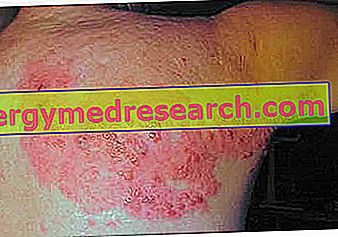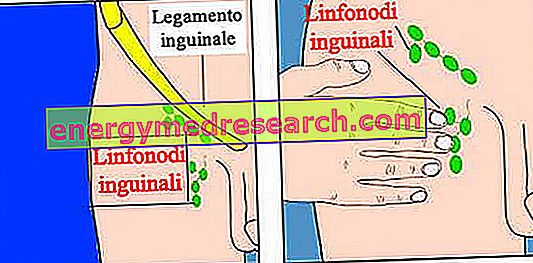Generality
The presence of a hair ingrown in the groin is a disorder as frequent as it is annoying.

It is a condition that typically (but not exclusively) occurs due to hair removal or epilation and whose presence can give rise to itching and, sometimes, even to pain.
The formation of an ingrown hair in the groin can occur indifferently both in female and male individuals, but it seems to interest more people with particularly thick and curly hair.
What is that
What is Inguine Fur?
We talk about ingrown hair in the groin when the terminal part of this cutaneous appendage - located in the inguinal region - develops inside the skin and not outside it as, instead, it should occur under normal conditions. The presence of an ingrown hair should not be considered as a disease, but rather as an annoying discomfort that in some cases could give rise to even severe inflammatory phenomena and infections.
Causes
What are the Causes of Ingrown Fur in Inguine?
The main cause of formation of an ingrown hair in the groin lies in shaving with razor and in epilating performed mainly by waxing or epilator .
Did you know that ...
Often, the terms "hair removal" and "hair removal" are used improperly as synonyms. In fact, when we talk about "depilation", we should refer only and exclusively to the removal of the part of hair that comes out of the skin. On the contrary, when we talk about "hair removal" we should refer to the removal of the entire hair, including the bulb.
Hair removal
The formation of a hair ingrown in the groin is a more common phenomenon than one could imagine and, in most cases, it is caused precisely by shaving with the razor in the groin region.
The reason why hair removal is one of the main causes of ingrown hair formation is to be found in the way it is performed. In fact, when you shave in particularly delicate or uncomfortable areas to reach, as could be the inguinal region, it is customary to stretch the skin to facilitate the passage of the razor. When the skin is released, the remaining untrimmed hair shaft tends to withdraw into the hair follicle. In doing so, however, there is a risk that the hair - whose tip is sharp due to the cut - grows incorrectly and "curved" below the skin.
In addition to this, the razor can cause small cuts or abrasions with consequent crusting and scar tissue that can clog the hair follicle, thus favoring the formation of ingrown hairs.
Hair removal
Also the depilation performed by waxing or epilator can favor the formation of an ingrown hair in the groin.
In this case, however, the hair is completely torn off, including the bulb. Therefore, the cause of the formation of ingrown hairs following epilation is to be found in the obstruction of the hair follicle and the ostium of the hair by cellular debris or foreign substances (for example, wax not completely removed or removed inadequately ). Precisely for this reason it is always recommended to prepare the skin before epilating and to treat it at the end (see chapter "Remedies and Tips").
Did you know that ...
In truth, an ingrown hair in the groin can grow abnormally even if the area of skin in question has not been subjected to depilation or hair removal.
Risk Factors for Ingrown Ingrown Hair
Although the main causes of the formation of an ingrown hair in the groin are to be found in depilation and hair removal techniques, there are many risk factors that can expose the individual to this problem. Among these - in addition to possessing thick and curly hair - we remember:
- Wear tight or close-fitting underwear or trousers;
- Poor hygiene that can cause an accumulation of dirt and cellular debris that can obstruct the ostium of the hair, preventing it from escaping.
Ingrown Hair Growth
How Does Ingrown Hair Grow?
A hair can incarnate developing "wrongly" below the skin in different ways (see figure).

In fact, it can:
- Grow at a sub-epidermal level, thus taking on a "curled" or "flattened" shape due to the lack of space.
- Grow at sub-epidermal level, letting only the tip come out of the skin while the rest of the stem remains "blocked" under the epidermis.
- Do not develop properly by re-entering the hair follicle when the outlet is blocked by cellular debris or scar tissue resulting from cuts or abrasions.
- Grow inside of another hair follicle.
Regardless of how the ingrown hair grows in the groin, its presence can cause the appearance of annoying symptoms (see next chapter).
Manifestations and Symptoms
How to manifest a Ingrown Hair?
A hair ingrown in the groin manifests itself as a small skin lesion, usually red and often in relief. Sometimes it is possible to see the hair curled or flattened at a sub-epidermal level.
What symptoms does Ingrown Fur do?
A hair ingrown in the groin causes local irritation and inflammation that can be associated with various symptoms, such as:
- Feeling of annoyance;
- Pain, generally (but not exclusively) to pressure;
- Itch;
- Swelling;
- Pus formation.
Of course, the type of symptoms manifested and their intensity may vary from individual to individual.
However, the aforementioned symptomatology can become even more annoying if the ingrown hair in the groin is formed near areas in which the skin is in close contact and / or is subject to rubbing with underwear. For example, pain and discomfort may be accentuated if the ingrown hair grows at the point where the elastic of the briefs will rest.
Complications arising from the presence of Ingrown Fur
Although the presence of a single ingrown hair does not cause great damage to the individual, it is possible that complications develop; although, in principle, these tend to occur when there is the concomitant presence of more large ingrown hairs. These, in fact, can evolve and favor the appearance of papules, pustules and pus-infarcted boils . In such a situation, it is not uncommon to develop folliculitis .
In addition to what has been said so far, following the inflammatory processes and any infections that may occur in correspondence with one or more ingrown hairs in the groin, once the above skin lesions have healed, they could give way to skin discoloration (hyperpigmentation post-inflammatory), scars, or worse, keloids .
Please note
When a hair ingrown in the groin causes inflammation and intense pain, it is good to seek medical attention and avoid any type of DIY removal or treatment.
Remedies and Tips
Remedies for Eliminating Ingrown Fur
In the event that the problem of ingrown hair in the groin should not resolve spontaneously, it is possible to resort to the mechanical removal of the same. To do this you can use:
- A tweezers for eyebrows previously sterilized .
- A sterilized needle with which to gently extract the hair.
Before proceeding with the removal, it can be useful to carry out hot compresses to soften the skin and thus facilitate the outflow of the hair. At the end of the operation, however, it would be good to disinfect the affected skin area (for example, by using hydrogen peroxide).
Please note
The aforementioned methods of removal, however effective they may be, are not recommended due to the risk of causing injury and bleeding .
Removal with Chemical Substances
To eliminate a hair ingrown in the groin it is also possible to resort to chemical removal using a depilatory cream . This product, in fact, acts by weakening the structure of the hair until it is eliminated. Furthermore, the use of depilatory creams for the removal of unwanted hair greatly reduces the risk of hair becoming incarnate.
Pharmacological treatment
The pharmacological treatment of an ingrown hair in the groin should only be carried out if prescribed by the doctor and only if there are complications such as severe inflammation and / or infections. In such situations, the doctor may decide to prescribe the administration of drugs for topical use with antibiotic, antiviral or antifungal action, depending on the pathogenic agent responsible for the infection.
The use of corticosteroid drugs, on the other hand, is reserved for cases of ingrown hair in the groin which is particularly severe, since it is a powerful anti-inflammatory drug with side effects that cannot be underestimated.
Finally, to resolve complications such as skin discoloration, it is possible to use chemical peels . However, since the inguinal region is not particularly exposed, there is a tendency to avoid the use of similar aesthetic medicine treatments.
Useful Tips to Prevent Ingrown Hairs Formation
To avoid facing the much feared and annoying hair ingrown in the groin, it is good practice to prepare the skin to remove hair and treat it once the operation is completed. More in detail, it can be useful to prevent ingrown hair growth:
- Exfoliate the skin before and after depilation or epilation : this treatment carried out with physical exfoliants helps eliminate possible cellular debris and dirt, reducing the risk of obstruction of the hair follicle and ostium. You can use both physical exfoliants ready for use and available in perfumery, and exfoliants do it yourself . If desired, it is also possible to use the horsehair glove .
- When the hair is removed by shaving with a razor, prepare the skin before the operation by softening it with warm water . In fact, shaving dry skin increases the risk of ingrown hair growth. In addition to what has just been said, when the hair is removed with a razor it is good:
- Avoid shaving in the opposite direction of hair growth.
- Avoid putting too much pressure on the skin with the instrument in question.
- At the end of hair removal or epilation, use moisturizing and nourishing products to prevent skin dryness.
However, it should be pointed out that, even following the aforementioned advice, the possibility of a fur forming in the groin cannot be completely excluded.



